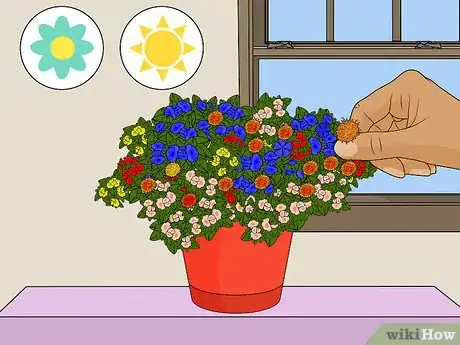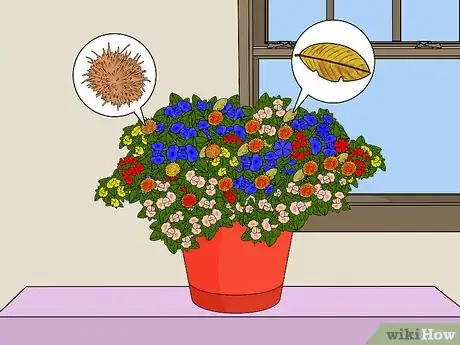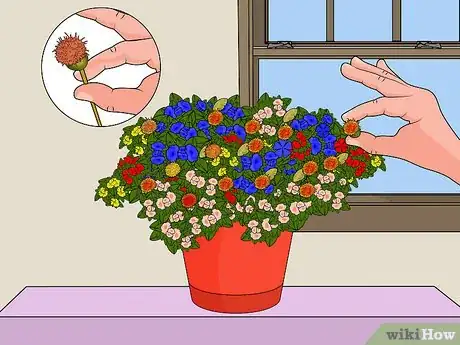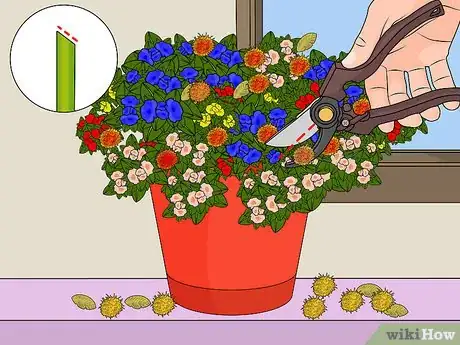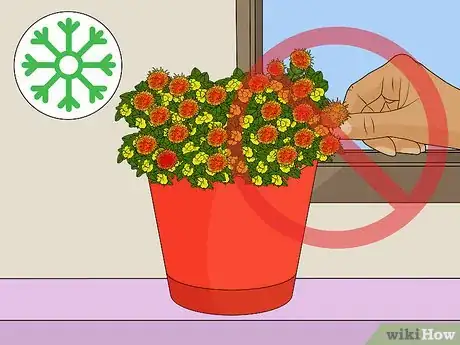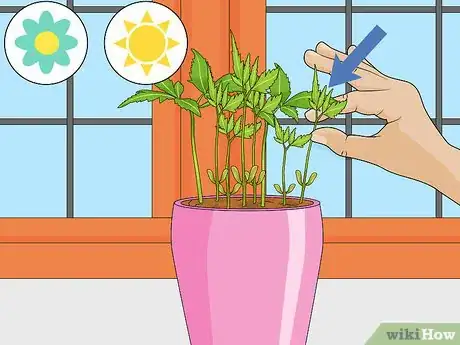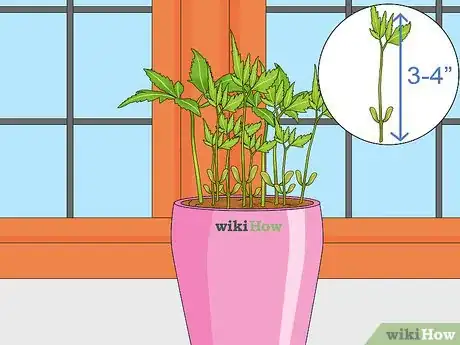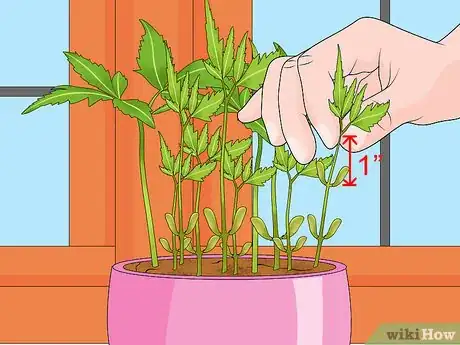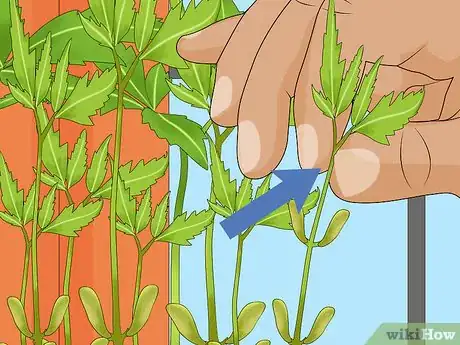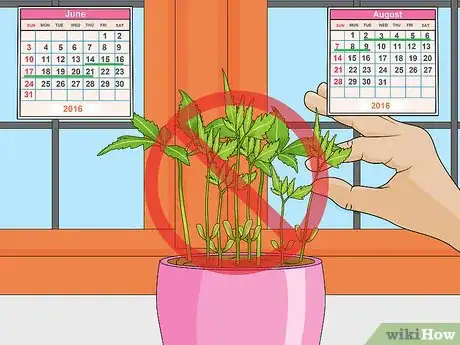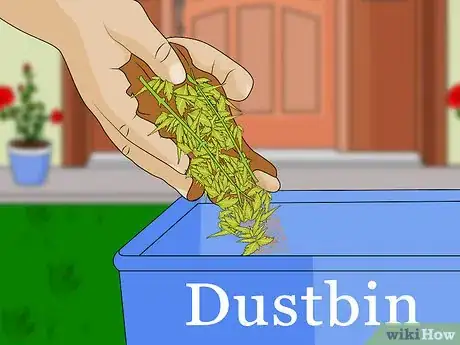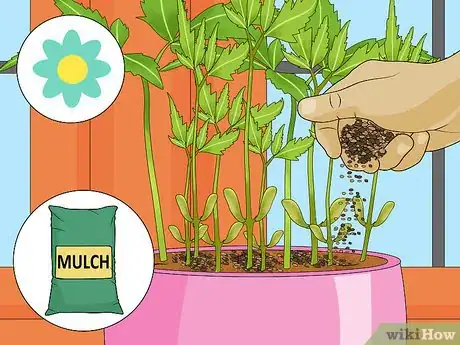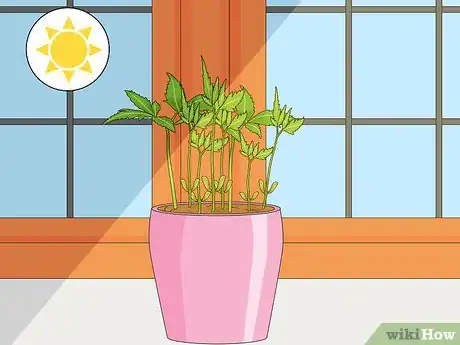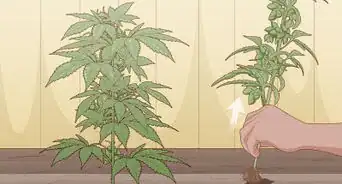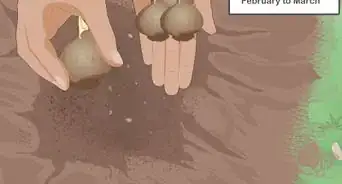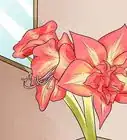This article was co-authored by Maggie Moran. Maggie Moran is a Professional Gardener in Pennsylvania.
This article has been viewed 92,865 times.
Deadheading is a gardening term that refers to the trimming off of dead blooms and growths on a plant. Though you may be nervous to go after your mum plants with a pair of garden shears, deadheading is actually an extremely healthy process for your plants that will make them look tidier and more beautiful. Mums in particular benefit from deadheading and the pinching back of their stems during the springtime to get them ready for their blooming period in late summer and early fall. Trimming and pinching your mums will keep them short and bushy, as well as propagate more side branches for a fuller and healthier-looking plant.
Steps
Cutting off Dead Growths
-
1Deadhead mums in late spring to mid summer. The best time to deadhead or prune mums you are growing outside is during the late spring up to mid summer. This is right before blooming season, so the flowers have time to branch off from the cut stems. Deadheading during the warm season also makes it less likely that the vulnerable cut areas will be exposed to cold temperatures.
- If you are growing your mums in a greenhouse or indoors, you can deadhead them as soon as you see dead growths since the mums won’t be exposed to cold weather.
-
2Find blooms that are wilted or dead. When it’s time to deadhead your mums, inspect the plant to find the flowers or branches that are spent. Most mum blooms are orange or yellow in color when healthy, and brown when dead or dying. They also are likely drier than the other healthy flowers of the plant, often with a papery and brittle texture to their petals.[1]Advertisement
-
3Pull off dead blooms with your fingers. If your mum plant only has a few dead blooms, you can simply pull off the browned flowers with your fingers. To do this, grip the stem of the mum right under the dead flower, then simply pinch and snap off the dead bloom.[2]
- If you are growing your mum indoors or in a greenhouse, this method is probably best for you since you can continuously deadhead throughout the year and don’t have to worry about exposing your mum to cold temperatures.
-
4Clip off bunches of dead flowers with shears. If many of the blooms of your mum plant are dead, but the stalks appear to be alive and are growing buds, use a pair of garden shears to clip multiple flowers off at a time. Angle the shears right under the dead blooms and clip, taking off the blooms from a whole section of the plant. Repeat until you have taken off all the dead blooms.[3]
-
5Shear at the bottom of the stem for major deadheading. If most or all of the blooms and stalks on your mum plant are dead, you’ll need to use a pair of gardening shears to deadhead your plant. As soon as you see new green growth from your mum plant emerging from the ground, take a sharp pair of gardening shears and clip all of the dead sections of plant as close to the ground as you can. This will eliminate not only the dead flowers, but also the dead stems of the mum plant so that it can start anew.[4]
- You may feel nervous about cutting off so much of the plant. However, if your mum is a perennial plant that went through a winter season, it’s necessary not only to cut off the flower but also the dead stems.
- Make sure that if you are doing a major deadheading that you do it during spring or early summer. This will give the new growths of the plant time to grow fully before blooming season in the fall.
-
6Don’t prune outdoor mums after they flower. Once your mums flower in the fall, you may be tempted to deadhead any dead flowers you see among the healthy blossoms. Resist this temptation if you are growing outdoor plants in a region that has a cold winter season, as clipping back flowers right before cold weather will leave your plant vulnerable.
Pinching to Encourage Bushiness
-
1Pinch mums during late spring and early summer. Pinching refers to the pinching off of the top of the stems of a plant to encourage bushy growth and blossoming. Pinching can be done alongside the removal of dead blooms in late spring to early summer, as doing it before winter can also cause the mum to be vulnerable to the cold weather.[5]
- Pinching is not strictly necessary but is a good addition to your deadheading routine, as it can make your plant fuller and healthier while keeping the shape of the plant compact and bushy.
-
2Identify leggy stalks to be pinched. Because pinching is best done on tall stalks that you want bushier and more fruitful, take a good look during the late spring and early summer for stalks that you want shorter. It’s best to pinch your mums once the new shoots that emerge in the spring are 3 to 4 inches (7.62- 10.16 cm) high.[6]
- Also look for any tips that look dead or browned.
-
3Grasp the tip under the first set of leaves. Once you have identified some stalks that should be pinched, grasp the tip of a shoot right under the first set of leaves, about ½ to 1 inch (1.27 to 2.54 cm) down the stem from the tip.[7]
-
4Pinch the tip off with your fingernails. Use your fingernails to pinch off this tip and discard the pinched off tip of the plant. Repeat the process of pinching on all unhealthy or overly-tall stems.[8]
- Pinching not only shortens the height of a tall plant, it also allows encourages rapid growth of leaves and blooms right below the pinched off area.
-
5Stop pinching in mid June to early August. The optimal time to stop pinching for most mums is in mid July so that the plant has time to blossom and grow before blooming season. If your mum plant is an early cultivator then you should stop around mid-June, and if it is a late cultivator like a “Minnyellow” or a “Minngopher” mum, you can get away stopping pinching around early August.
- Look up your type of mum to see whether it is an early or a late cultivator.
Caring for Your Mums After Deadheading
-
1Dispose of the dead blooms and branches. After deadheading your mums, it’s important to get rid of the dead blooms, branches or stems that you have taken off in the process. Pests like slugs and snails can lay their eggs in the dead foliage and overtake the mum, which will harm the plant.
-
2Mulch your mum during spring. A good time to mulch your plant is after deadheading and pinching because it can add nourishment to the soil and protect the vulnerable plant against cold spells. Add a few inches of lightweight mulch in the spring or summer after deadheading, and add mulch in mid to late fall to protect mums against the winter.[9]
-
3Make sure that mums get sun after pruning. Mums need plenty of sun, and it’s a good idea to give them the nourishment they need right after pruning. After deadheading an indoor mum, bring it to a sunny windowsill. Try to time the deadheading of outdoor mums so that it receives at least a few hours of sunlight after the deadheading process. of soil feels dry, add water.”|}}
Expert Q&A
Did you know you can get expert answers for this article?
Unlock expert answers by supporting wikiHow
-
QuestionHow do you take care of mums?
 Maggie MoranMaggie Moran is a Professional Gardener in Pennsylvania.
Maggie MoranMaggie Moran is a Professional Gardener in Pennsylvania.
Home & Garden Specialist
-
QuestionDo mums come back if you plant them in pots?
 Maggie MoranMaggie Moran is a Professional Gardener in Pennsylvania.
Maggie MoranMaggie Moran is a Professional Gardener in Pennsylvania.
Home & Garden Specialist
-
QuestionDo mums rebloom?
 Maggie MoranMaggie Moran is a Professional Gardener in Pennsylvania.
Maggie MoranMaggie Moran is a Professional Gardener in Pennsylvania.
Home & Garden Specialist
Things You’ll Need
- Sharp gardening shears
- Mulch
References
- ↑ https://www.youtube.com/watch?v=DE9gc7oQdPI
- ↑ https://www.youtube.com/watch?v=P7_m60el8XY
- ↑ http://www.midwestgardentips.com/deadheading.html
- ↑ https://www.youtube.com/watch?v=wWuYdZaZVdw
- ↑ http://www.finegardening.com/chrysanthemums
- ↑ http://www.finegardening.com/chrysanthemums
- ↑ http://www.finegardening.com/chrysanthemums
- ↑ http://www.finegardening.com/chrysanthemums
- ↑ https://www.todayshomeowner.com/growing-chrysanthemums-in-your-garden/
